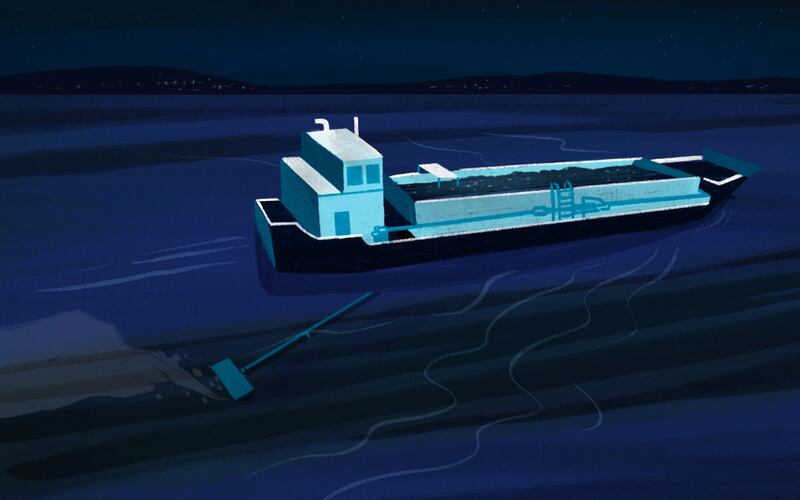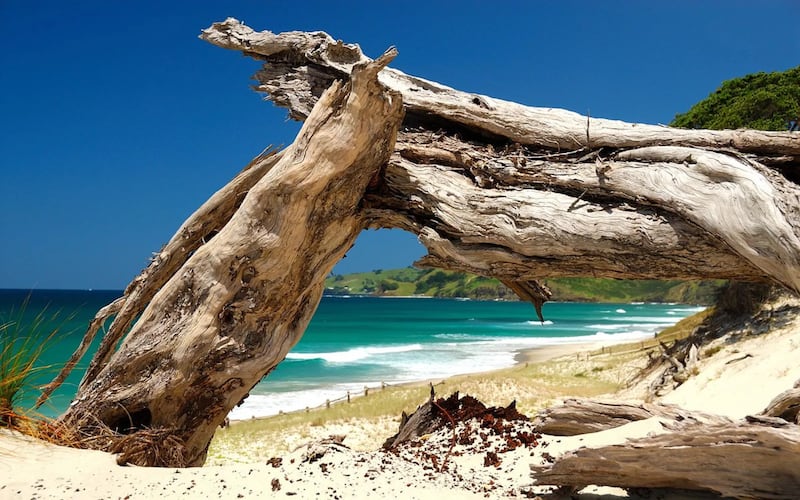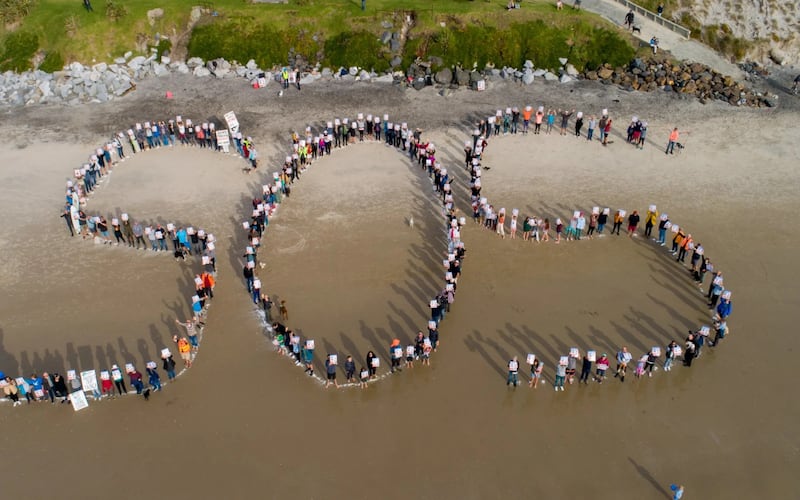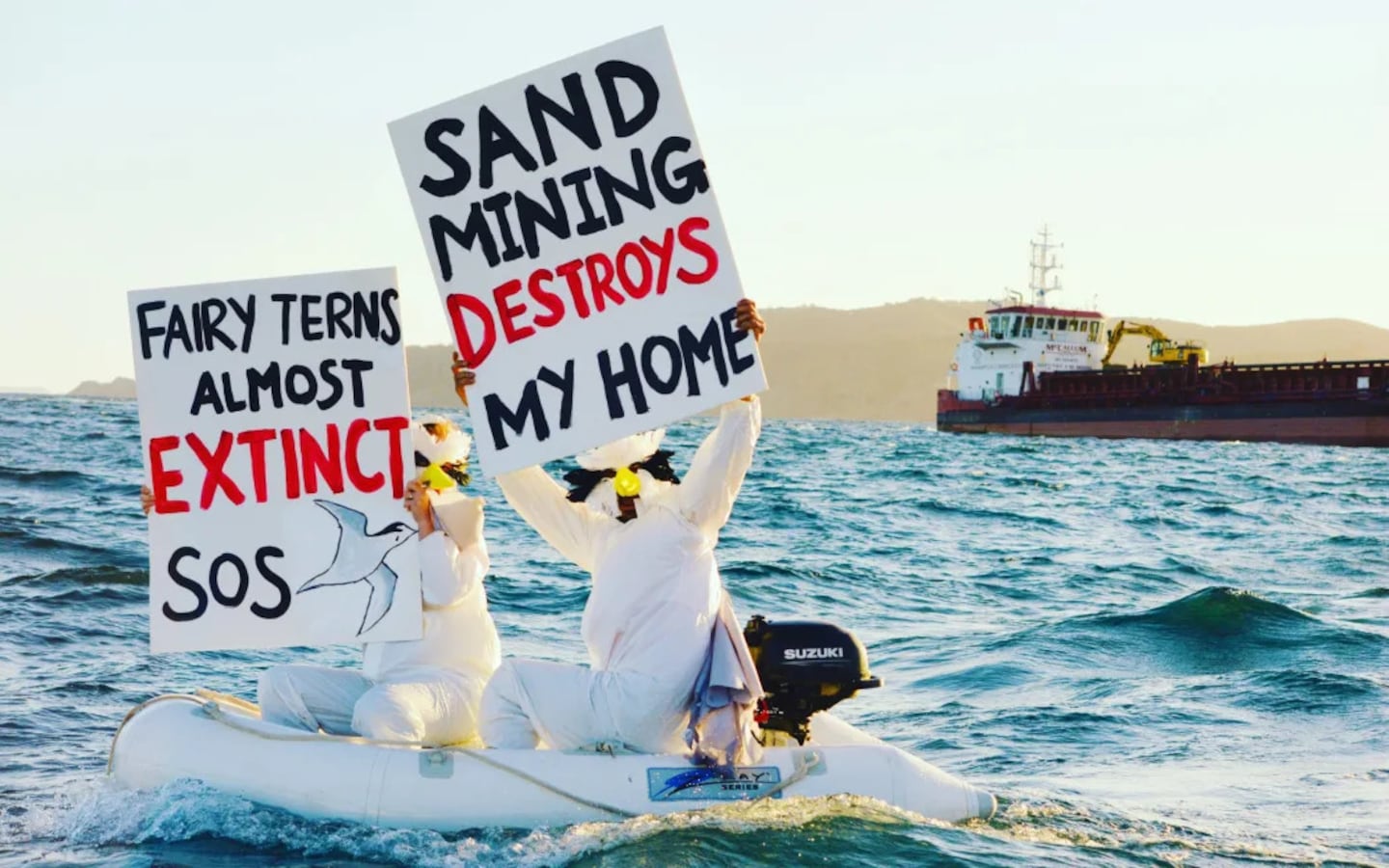This story was first published by RNZ.
One man and a re-purposed boat helped beat back a plan to take two million cubic metres of squeaky white sand from a Northland beach. Could the government’s Fast Track Bill have the final say?
Ask Damon Clapshaw why he engaged in a years-long legal battle against sand mining and you get a long-winded answer which boils down to not liking being lied to.
He never set out to be an activist, “I just got a bit wound up,” he says, and one thing led to another until he ended up embroiled in a court case.
The itch he couldn’t give up scratching started from watching the sand dredging boat make its slow night sweeps up and down the Pākiri coast, north of Auckland. Lit up like a “stadium” it would inch along the shore. To his eyes, it always appeared to follow the same path and be the same distance from the beach, rather than roam over a much larger area which it had consent to dredge.
A scientist he chatted with suggested dredging the same path would cause depressions in the sea bed, so Clapshaw sent him publicly available location data from the boat to analyse.
“He came back to me and said: ‘You know what Damon, they are doing that same line literally all the time. There’s something going on that’s weird. So your gut instinct was right. If they’re doing that they’re probably causing pits and disturbances on the seabed.’”
Clapshaw kept scratching the itch. Calling in a favour, he enlisted the help of octogenarian treasure hunter Keith Gordon. He’d worked with Clapshaw’s father and had the skills and equipment to map the seafloor.
As Clapshaw describes it, Gordon was sceptical about finding anything saying, “you’re slightly wasting my time, but I like your dad so I will do it as a favour to him”. Gordon refused to use his “fancy” boat for the task so they “blagged” the use of another boat, and surveyed the sea floor following the coordinates of the dredging boat.
“When Keith looked at his data the next day, he said: ‘Woah, geez, there’s definitely something down there’,” says Clapshaw.

The survey uncovered trenches in the sea floor. These were deeper, wider and longer than even Clapshaw expected. At most, Clapshaw says they should have been no deeper than “the active sand layer” - which was 1 metre, but what the treasure hunter’s sonar found were up to 2.7m deep, 15m wide and 3 kilometres long. He estimated there were up to a dozen of these trenches running parallel off the shore. One expert later described the area as resembling a “ploughed paddock”.
The discovery of the deep trenches called into question the survey reports the sand mining company had commissioned. These made no mention of any trenches, merely stating the average change in depth between 2011 and 2018 was less than 1.5m. The report noted there were no conspicuous objects on the seabed. Without shipwrecks or reefs, Clapshaw can’t comprehend how trenches 2.7m deep wouldn’t count as conspicuous. “It’s like walking into an empty room and not seeing the tree trunk you trip over,” he says.
It highlighted two things for him. Firstly, that monitoring of the effect of the dredging on the seabed either hadn’t happened, had been done poorly or results hadn’t been shared. This seemed strange to him as the area with the trenches wasn’t a “hidden corner” of the permitted dredging area, “this was the equivalent to the front door”.
Secondly, trenches this deep may interfere with any natural flow of sand and sediment from deeper waters to the shoreline, which locals worried was being eaten away by the decades of dredging.
“I’m a bit like a builder. I knocked on a wall and the wall collapsed, and then the building collapsed. More and more things I investigated just didn’t make sense, or fell away,” he says. “I’m probably the worst person to meet if I think I am being lied to.”
The company eventually admitted to knowing about the trenches but said it didn’t share the information with its own scientific expert on coastal processes. When pressed in court why, Clapshaw says the company’s response amounted to: “we stuffed up”.
The company’s expert later told the court the trenches would interrupt the movement of sand but said as they only covered 15 percent of the length of the area, the effect was small, and would be temporary as they slowly filled with sand. He said future dredging practices “would not allow for the creation of new trenches”.
But the non-disclosure of the trenches wasn’t the only stuff up. A further independently-conducted survey found grooves in the seabed showing the boat sometimes dredged too close to shore.
Another mistake was made by the company’s scientific expert who initially estimated 145,000 cubic metres of sand washes into the area each year, replenishing the surroundings. His calculations were disputed by numerous experts not engaged by the company. He later conceded he had made a mistake. The actual figure was closer to 12,000.
Clapshaw’s evidence - gained through favours and blagging of a boat - was used in two battles against sand mining. One, against resource consent where independent commissioners for Auckland Council turned down two of three consents for sand mining. He joined a second fighting the mining company’s appeal of a consent rejection in the Environment Court.
The Environment Court’s decision, released in April, rejected the application by the sand mining company to overturn the council’s decision. The court said evidence about the ecological effects of the mining provided by the company had been “patchy”, “inconclusive” and even “incorrect” in the past. It also found the effect on mana whenua couldn’t be mitigated.
When Clapshaw heard the news he was happy “for a bit”.
There’s a couple of clouds hanging over the win. After losing twice, the company is having a third go at getting approval and has appealed the Environment Court’s decision in the High Court.
However, even if the company loses again, there’s a new potential card up its sleeve. Proposed Fast Track legislation could make any court victory worthless. The legislation could allow projects rejected by courts to go ahead, and give ministers the power to overrule a court’s decisions. Another key feature of the legislation is the silencing of public voices.
Motivated members of the public like Clapshaw, who refuse to give up scratching an itch, won’t get a chance to provide any information to a fast track expert panel.

A city hungry for sand
The consent to mine sand at Pākiri was initially held by Kaipara Ltd. It contracted another firm, McCallum Brothers, to do the work. In 2021, Kaipara Ltd sold the consent to McCallum Bros, which has carried on the mining and legal efforts to get another two million cubic metres of Pākiri’s sand over 20 years. No one from the company would be interviewed for this story but some of its arguments are laid out in official documents.
They want a renewal of a similar consent which expired in 2023. Other consent applications to mine closer to shore have been turned down by independent commissioners or abandoned by the company.
Other sources of sand exist, including manufactured sand made by crushing rocks. But the white sand of Pākiri, which squeaks when it’s walked on, is special.

It has an ideal shape and mineral content for use in high strength concrete and has been used in the City Rail Link and the Central Wastewater Interceptor. It’s used to help build new homes. And it sells for between $35 and $45 a tonne.
In 2021, McCallum Bros supplied almost half of Auckland’s sand - 346,600 tonnes. Kaipara Limited, its rival, supplied 393,367 tonnes. By 2048, it’s estimated even more sand will be needed to cater to the growing city. One estimate puts future needs between 1.17 and 1.8 million tonnes a year.
It’s the kind of demand the coalition government seems to have in mind for consideration under its Fast Track legislation.
When the bill was announced by Chris Bishop, the minister responsible for RMA Reform, Infrastructure and Housing, he said consents were taking too long to get and costing too much.
“We are determined to cut through the thicket of red and green tape holding New Zealand back.”
Housing, roads and infrastructure are exactly the types of projects the legislation wants to get going and the sand from Pākiri’s waters is a key component of much of the concrete used in Auckland.
If McCallum Bros seeks approval under the fast track legislation, the expert panel considering the application will be assessing it under a different lens to the Environment Court. The panel must give priority to the purpose of the fast track legislation, which is to facilitate the delivery of infrastructure and development projects. This is different to the more holistic direction of the Resource Management Act which attempts to balance progress and the environment and calls for sustainable management of resources.
This worries Parliamentary Commissioner for the Environment Simon Upton, who described the bill as liberating “the big end of town” while silencing the voices of people who might be affected by projects.
While McCallum Bros hasn’t confirmed it has applied to be considered for fast tracking, it did provide feedback on the fast track bill saying it supports the introduction of the legislation, with a few suggested amendments. These include amending the wording of clauses to ensure sand extraction is included and allowing consents to remain lodged under the RMA while fast track approval is sought, rather than needing to withdraw them. This would allow the company to continue to appeal the Environment Court’s decision while simultaneously trying to get the go ahead under fast track rules.
It supported locking the public out of the fast track process, specifically endorsing a clause in the bill which states: “There is no requirement for a panel to hold a hearing in respect of a consent application or notice of requirement and no person has a right to be heard by a panel.”

The voices of Pākiri
Damon Clapshaw jokes about being “Nigel no-friends” on Environment Court calls as a solo submitter with a fixation on trenches and consent breaches, but he was far from alone. Several local and national groups mobilised against the mining, with a variety of concerns.
The groups included Friends of Pākiri Beach, the Fairy Tern Society, Forest & Bird, Mangawhai Harbour Restoration Society, Environmental Defence Society, Te Arai Interests, Te Whānau o Pākiri, and Manuhiri Kaitiaki Charitable Trust.
Between the groups, experts were put forward on coastal processes, damage to the sea floor, the effects on bird and sea life and the effects on mana whenua.
“They [McCallum Bros] finally met a very very strong and determined community, which has punched above its weight,” says Ken Rayward.
Rayward has been a campaigner-at-large, mixing between the groups opposed to sand mining to ensure they “weren’t spending our meagre resources all on the same thing and the same science base”.
The quality of the evidence the various local groups supplied forced the sand mining company’s expert witnesses to change their views, Rayward says. Without the information, he’s certain wrong decisions would have been made.
Friends of Pākiri Beach was one of the groups which hired experts to assess the impact of mining on the beach.
“If you think of a bucket full of sand, if you take it out somewhere, it’s eventually going to show up as erosion,” says treasurer Nick Wiliams.
According to Williams, whose family has been part of the community for decades, photos from the past show the beach in a much healthier condition. While it’s normal for sand to shift around on beaches, “at the very least, we’ve said it’s uncertain that you’re not harming the environment”.
The group engaged two experts to give evidence. The first, a civil engineer with coastal engineering expertise to provide evidence about the impact offshore dredging could have on the area, and the second an engineering expert on other sources of sand which could be used in Auckland.
The taking of the sand doesn’t just contribute to beach erosion, says Williams. Dragging the dredge along the sea floor also impacts wildlife. “We used to have all these horse mussels wash up on the beach, but we haven’t seen them for probably 20 or so years because they got dredged up and destroyed.” Any patches of stony coral dotted on the seabed can also get obliterated.
There’s also worry the disruption to the ecology could impact New Zealand’s rarest bird which teeters on an extinction knife’s edge. Fewer than 40 breeding age fairy tern remain and the loss of a single bird would put the species survival in an even more perilous position.
“There’s endangered bird life. There’s uncertainty about coastal effects. There is, obviously the mana whenua values and strong opposition by all the relevant iwi who oppose this,” says Williams. “On every ground you look, it failed.”
Among those who spoke to the mana whenua values was hapu group Te Whānau o Pākiri. Chairperson Olivia Haddon says the group is opposed to the sand being taken from their shores because of the impact it has on the wellbeing of the environment. She says the extraction has a massive impact on the traditional value sets. “It’s an insult on our kaitiakitanga.”
Haddon’s family has fought against sand mining for decades. She gave evidence to the court on the cultural landscape and the traditions associated with the hapu’s lives in the area.
The taking of the sand “disables” her family’s ability to act as kaitiaki or guardians of their environment, she says.
The price of progress
The court took the concerns raised by Haddon and other iwi, such as Ngāti Manuhiri, seriously.
Its decision described the desires of mana whenua and McCallum Bros as having been on a collision course.
“For mana whenua, the relationship is whakapapa based and it forms part of their tribal history and identity. For some the embayment has become their home, a place where they enjoy coastal beauty and tranquil serenity. For others the relationship is statutory based, compelled to protect the flora and fauna of the embayment for all New Zealanders, including providing an active voice for those we cannot hear from in the resource management process i.e., the tara iti (the critically endangered New Zealand fairy tern).
“For McCallum Bros, the relationship is effectively a commercial one, with their sand mining business providing good quality sand for the concrete needs of New Zealand’s biggest city.”
The court noted there were clear benefits to allow the extraction of sand, saying it has been a cheap and plentiful source of sand for 80 years but this came at a price. “These economic benefits to Auckland and to McCallum Bros and others have occurred at direct cost to mana whenua and the embayment itself.”
Along with the effects on the mana whenua the court had doubts about the effects of sucking two million tonnes of sand from the area.
It noted there was a dearth of information from the company about the likely environmental impact: “There appears to have been an assumption by the Applicant that it was for the opposition parties to prove that there was an adverse effect.”
It said it was unable to assess risk because although earlier consents the company had gained were granted with environmental monitoring as a condition, “that produced to us was patchy, inconclusive, and as to shore effect incorrect.”
The overall finding from the court was that the need for high quality sand for Auckland didn’t trump the lack of information on coastal processes like sand movement, its effect on the ecology and species in the area and the impact on the mana whenua.

Dual duels
There’s a sense of quiet resignation to the fact that despite years of fighting and two victories, the battle isn’t over. Nobody seems surprised the company has appealed the Environment Court decision.
While any appeals are ongoing, all parties agreed McCallum Bros can continue to take sand, a deal made when the company abandoned a consent which had been granted for an area closer to shore. The stadium of lights will continue its evening patrols up and down Pākiri’s shore.
The groups are cautiously confident about the appeal - they feel the Environment Court decision was thorough. But when it comes to the Fast Track Bill, the tone fluctuates between indignation and concern.
While Bishop has recently softened his stance on some aspects of the bill, public input doesn’t seem to be up for discussion. “I do not expect that allowing submissions on individual projects will be revisited,” he said.
Rayward thinks if the project ends up in the fast track system, it would be a travesty of justice.
“To have it enabled to be resurrected, because of the fast track introduction would be an indictment on our whole system.”
The fast track system would cut out much of what the consent hearing and court case uncovered, he believes. “We wouldn’t have had the expert witnesses giving background. We wouldn’t have had the cultural impacts being openly presented. We wouldn’t have had the alternate supply options presented.”
Williams believes what’s happened at Pākiri is an example of why the fast track process is inappropriate.
“It’s taken parties who have an interest in the area to put forward a whole lot of extremely valid and important information,” says Williams.
Haddon thinks projects courts have rejected shouldn’t be revived under fast track legislation. Under the legislation, iwi groups may get a say, but hapu groups like hers won’t, she says.
Fast track legislation also prioritises economic considerations higher than the Resource Management Act does and “that’s left us with six kilometres of desecrated biogenic habitat,” she says.
Clapshaw agrees, calling the proposed fast track process deeply flawed. Much of the knowledge gained about the effect of sand mining in the area came from a diverse range of voices contributing evidence and a slow unearthing of facts.
It took him, as a motivated member of the public, and an octogenarian treasure hunter to discover massive trenches.
“Who would have thought that Joe Blow would do their own scan and find the trenches?”
If the commissioners or court relied on information the company provided, the trenches and their potential impact would never have come to light, nor would the huge mistake the company’s expert made in his calculation of the amount of sand washing into the area each year, he says.
If sand mining went ahead under fast track rules, he would feel more than just let down.
“I think for the first time in my life I would actually feel betrayed by my government. I’ve never said that before, I’ve never thought that before - I never thought I would think that before - but I would feel betrayed.”
Clapshaw remains committed to fighting via legal avenues, but he thinks a provocative act by the government might rally people to greater protest.
“It might have to be a case of we’re gonna go out there and have a flotilla of guys out on boats.”
By Farah Hancock of RNZ.


